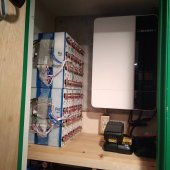TimC
WI/UP Border
- Joined
- Apr 17, 2020
- Messages
- 139
I've got two 48v 75 aHr batteries that I am going to wire in parallel to a Growatt 3000ES.
Which is the preferred method, or does it not make any difference?
A - run Pos and Neg of each battery to two bussbars (+ and -) and then a single wire from bussbars to breaker and then Growatt
B - run Pos to Pos on batteries, Neg to Neg on batteries, then a single Pos and single Neg from one battery to the breaker and then Growatt.
My load(s) are not big. Largest draw will be a 120v, 1.4kW, 12a Level 1 EV charger. I will not be pulling more than 2.0kW at one time.
Thanks, Tim
Which is the preferred method, or does it not make any difference?
A - run Pos and Neg of each battery to two bussbars (+ and -) and then a single wire from bussbars to breaker and then Growatt
B - run Pos to Pos on batteries, Neg to Neg on batteries, then a single Pos and single Neg from one battery to the breaker and then Growatt.
My load(s) are not big. Largest draw will be a 120v, 1.4kW, 12a Level 1 EV charger. I will not be pulling more than 2.0kW at one time.
Thanks, Tim



